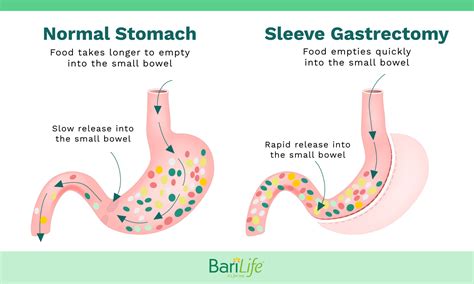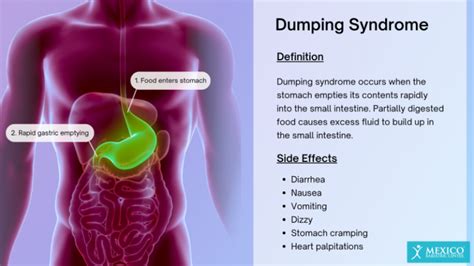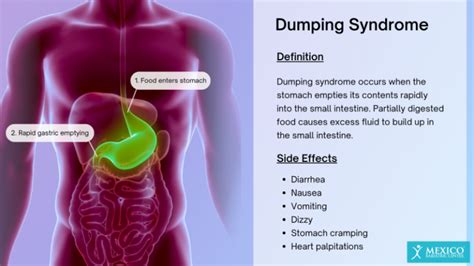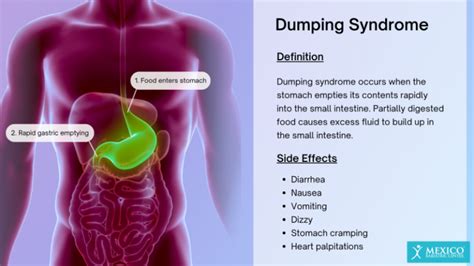Intro
Learn about Gastric Dumping Syndrome, a condition causing rapid stomach emptying, triggering digestive issues, and affecting gut health, nutrition, and overall well-being.
Gastric dumping syndrome, also known as rapid gastric emptying, is a condition that occurs when food, especially sugar, moves from the stomach to the small bowel too quickly. This can happen after surgery to remove all or part of the stomach, such as gastrectomy, or after other stomach surgeries like gastric bypass. The condition can cause a range of symptoms, from mild to severe, and can significantly impact a person's quality of life. In this article, we will delve into the world of gastric dumping syndrome, exploring its causes, symptoms, diagnosis, treatment options, and management strategies.
The importance of understanding gastric dumping syndrome cannot be overstated, as it affects thousands of people worldwide. The condition can lead to malnutrition, dehydration, and electrolyte imbalances if left untreated. Furthermore, gastric dumping syndrome can have a significant impact on a person's daily life, making it essential to recognize the symptoms and seek medical attention if necessary. By understanding the condition, individuals can take steps to manage their symptoms, prevent complications, and improve their overall health and well-being.
Gastric dumping syndrome is often associated with stomach surgery, but it can also occur in individuals who have not undergone surgery. Other factors, such as gastroparesis, a condition that slows down stomach emptying, can increase the risk of developing gastric dumping syndrome. Additionally, certain medications, like antibiotics and painkillers, can also contribute to the development of the condition. As we explore the topic of gastric dumping syndrome, it is essential to consider the various factors that can contribute to its development and the impact it can have on a person's life.
Causes of Gastric Dumping Syndrome

The exact mechanisms that lead to gastric dumping syndrome are complex and not fully understood. However, research suggests that the condition is related to changes in the way the stomach and small intestine interact. Normally, the stomach digests food slowly, releasing it into the small intestine in a controlled manner. In individuals with gastric dumping syndrome, food moves too quickly from the stomach to the small intestine, leading to a range of symptoms.
Risk Factors for Gastric Dumping Syndrome
Several risk factors can increase the likelihood of developing gastric dumping syndrome. These include: * Stomach surgery, such as gastrectomy or gastric bypass * Gastroparesis, a condition that slows down stomach emptying * Certain medications, like antibiotics and painkillers * Eating high-sugar or high-fat foods * Drinking carbonated beverages * Having a family history of gastric dumping syndromeSymptoms of Gastric Dumping Syndrome

In some cases, individuals with gastric dumping syndrome may experience more severe symptoms, such as:
- Dehydration
- Electrolyte imbalances
- Malnutrition
- Weight loss
Diagnosing Gastric Dumping Syndrome
Diagnosing gastric dumping syndrome can be challenging, as the symptoms can be similar to those of other conditions. A diagnosis is typically made based on a combination of medical history, physical examination, and diagnostic tests. These tests may include: * Upper endoscopy, to visualize the stomach and small intestine * Gastric emptying study, to measure the rate at which food leaves the stomach * Blood tests, to check for electrolyte imbalances and other complicationsTreatment Options for Gastric Dumping Syndrome

Dietary changes may include:
- Eating small, frequent meals
- Avoiding high-sugar and high-fat foods
- Drinking plenty of water
- Avoiding carbonated beverages
- Eating foods high in fiber and protein
Medications may be prescribed to:
- Slow down stomach emptying
- Reduce symptoms of nausea and vomiting
- Manage diarrhea and abdominal pain
Lifestyle modifications may include:
- Avoiding strenuous exercise
- Getting plenty of rest
- Managing stress
Managing Gastric Dumping Syndrome
Managing gastric dumping syndrome requires a long-term commitment to dietary changes, medication, and lifestyle modifications. Individuals with the condition should work closely with their healthcare provider to develop a personalized treatment plan.In addition to medical treatment, there are several self-care strategies that can help manage symptoms of gastric dumping syndrome. These include:
- Keeping a food diary to track symptoms and identify trigger foods
- Avoiding eating before bedtime
- Avoiding tight clothing that can put pressure on the stomach
- Practicing relaxation techniques, such as deep breathing and meditation
Complications of Gastric Dumping Syndrome

It is essential to seek medical attention if symptoms of gastric dumping syndrome persist or worsen over time. With proper treatment and management, individuals with the condition can reduce their risk of complications and improve their overall health and well-being.
Preventing Gastric Dumping Syndrome
While it may not be possible to prevent gastric dumping syndrome entirely, there are several steps that can be taken to reduce the risk of developing the condition. These include: * Eating a healthy, balanced diet * Avoiding high-sugar and high-fat foods * Drinking plenty of water * Avoiding carbonated beverages * Managing stress * Getting plenty of restBy taking these steps, individuals can reduce their risk of developing gastric dumping syndrome and improve their overall health and well-being.
What is gastric dumping syndrome?
+Gastric dumping syndrome is a condition that occurs when food, especially sugar, moves from the stomach to the small bowel too quickly, leading to a range of symptoms.
What are the symptoms of gastric dumping syndrome?
+The symptoms of gastric dumping syndrome can include nausea and vomiting, diarrhea, abdominal pain and cramping, bloating and gas, weakness and fatigue, dizziness and lightheadedness, and rapid heartbeat.
How is gastric dumping syndrome diagnosed?
+Gastric dumping syndrome is typically diagnosed based on a combination of medical history, physical examination, and diagnostic tests, such as upper endoscopy, gastric emptying study, and blood tests.
What are the treatment options for gastric dumping syndrome?
+Treatment for gastric dumping syndrome typically involves a combination of dietary changes, medication, and lifestyle modifications, such as eating small, frequent meals, avoiding high-sugar and high-fat foods, and managing stress.
Can gastric dumping syndrome be prevented?
+While it may not be possible to prevent gastric dumping syndrome entirely, there are several steps that can be taken to reduce the risk of developing the condition, such as eating a healthy, balanced diet, avoiding high-sugar and high-fat foods, and managing stress.
In conclusion, gastric dumping syndrome is a complex condition that requires a comprehensive treatment approach. By understanding the causes, symptoms, diagnosis, treatment options, and management strategies, individuals with the condition can reduce their risk of complications and improve their overall health and well-being. If you or someone you know is experiencing symptoms of gastric dumping syndrome, it is essential to seek medical attention to receive a proper diagnosis and treatment plan. We encourage you to share this article with others who may be affected by gastric dumping syndrome and to comment below with any questions or concerns you may have.
